I wasn’t very happy when I lived in Washington DC. After The Washington Post shut down its video games desk Launcher, two months after I moved to town to run it, I felt lost and angry. I felt stuck: in a lease in a city I didn’t want to live in, in a job that had its upsides but simply wasn’t the one I’d overhauled my life for. Determined not to let my situation ruin my sobriety, and with most of my friends hundreds of miles away, I channelled all my feelings into riding my bike.
Despite being a car-centric city, DC and its surrounding areas have an excellent trail system and robust bike culture. I spent my weekends devising long, aimless loops around town; I joined group rides and themed rides and races and one queer-specific meetup full of terrifyingly fit older men in Spandex whom I gamely tagged after in my work pants. I threw myself into bikepacking, jumping from a couple short jaunts along the C&O Canal on a newly-purchased gravel bike into a three-day loop through Maryland farmland. After that, if I could think of someplace to go and map out an impractical way to bike there while sleeping in a tent along the way, I went. I did little overnights on the C&O and in a sweltering campsite off Virginia’s Washington and Old Dominion trail. I wandered through Virginia gravel; I biked (and failed to bike) to neighboring towns. I eventually took a train all the way to Pittsburgh just so I could spend a week biking back, and I still have a list of trips in the area I’d like to tackle even though I’ve moved away.
One of my more ridiculous dreams during this time was to bike to Frederick, Maryland to see the National Clustered Spires High Wheel Race, a penny farthing race around a few blocks in a small, historic town about 50 miles out of DC. Despite the minimal distance, I could never figure out a reasonable bike route to get there. This didn’t stop me from planning a trip and even reserving a campsite in 2023, but a warning from a colleague who attempted the ride and a mechanical issue on another ride the week before shook my confidence, and I ended up not going. But this weekend, a friend with family in the area agreed to drive me down from New York to finally see the race.
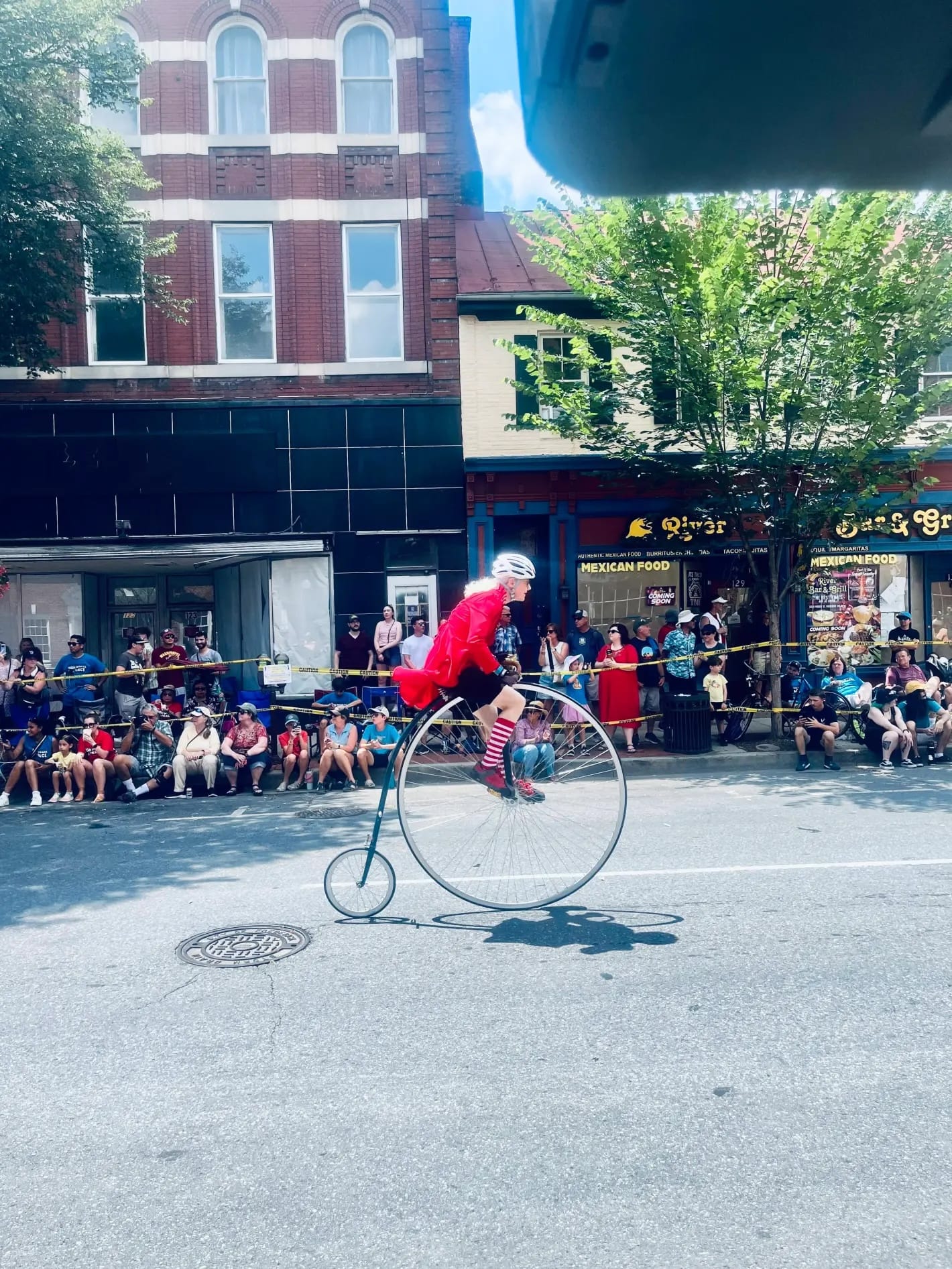
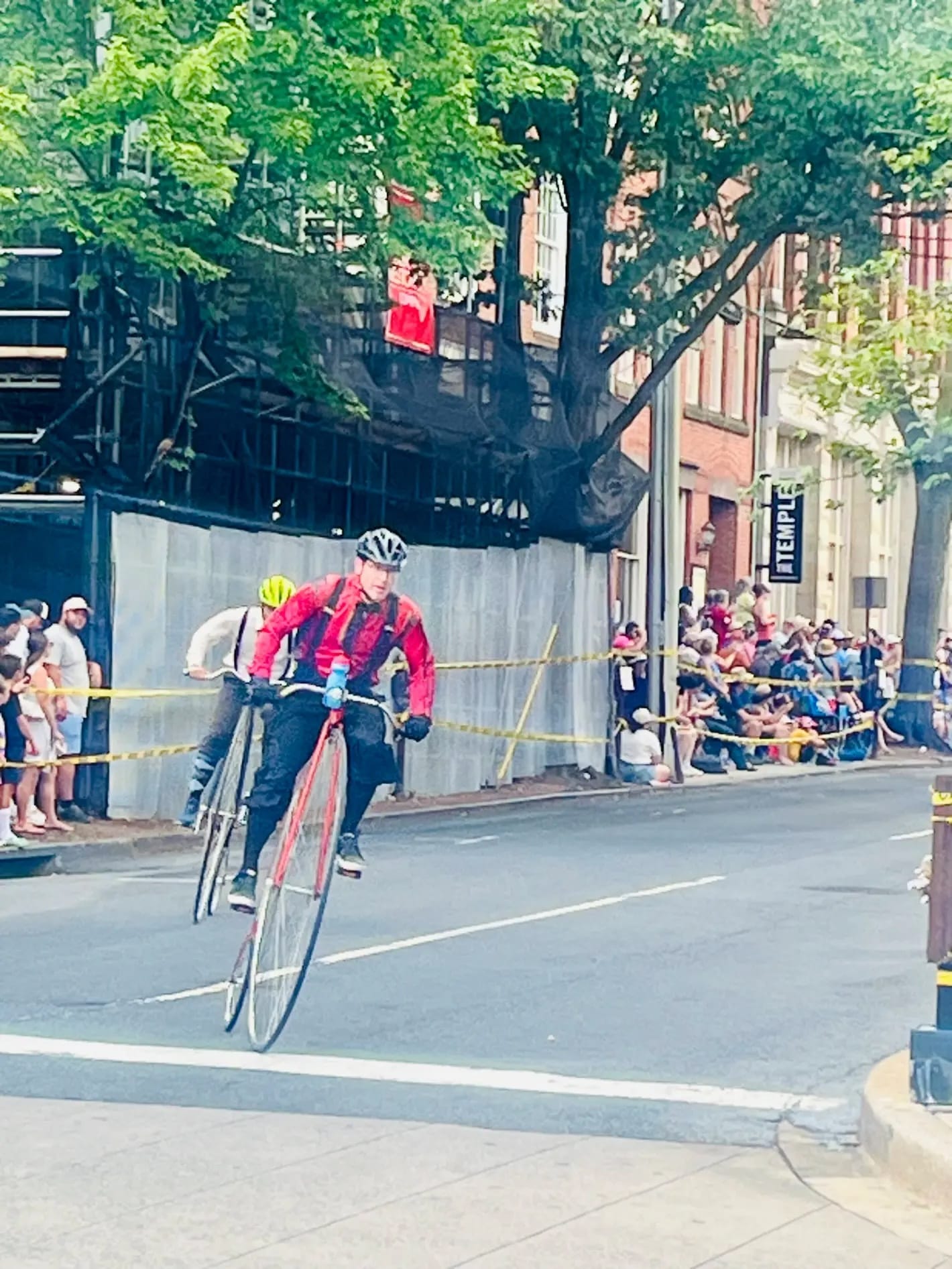
The National Clustered Spires High Wheel Race bills itself as “the only race of its kind in America” and “the largest high wheel race in the Western hemisphere.” (There are also penny farthing races in Sweden and England.) Started by Frederick couple Eric and Jeanne Rhodes in 2012, 2025 marked its 11th year. The format has changed over the years, and this most recent version had heats of riders competing in timed crits around a .4 mile section of Frederick’s downtown. The two qualifying rounds required riders to do as many laps as possible in 20 minutes, with the top riders going at a half-hour championship through a blisteringly sunny 90+ degree afternoon.
Rider Chris Meacham of Pennsylvania ultimately won the men’s division with 24 laps, while Melissa Eisdell, all the way from England, won the women’s division with 21. (The race itself was co-ed; the announcers said that 10 women competed this year out of a field of around 50, the most women who have ever competed.) Meacham told the Frederick News-Post, “People are so much more excited about this type of bike race than any other bike race I go to… People are freaking out, so that's amazing. It just feels comfortable and safe here.”
It is, frankly, pretty hard not to freak out when you see a penny farthing in real life instead of an old photograph. The penny farthing was invented in 1871 and was basically obsolete by the late 1880s thanks to the invention of the bike as we know it today, then called a “safety” bike due to how much safer it was than its predecessor. Without the drive train of today’s bikes, the penny farthing gets its speed from the size of its front wheel; the bigger the front wheel, the farther the bike goes with each wheel rotation, so a bigger wheel means a potentially faster bike. When these giant wheels start turning too fast for riders to keep up, they’ll drape their legs over the handlebars to get them out of the way of the spinning pedals, something I saw frequently at the race.
Those handlebars are one part of what makes the penny farthing so dangerous. Unlike the bikes we know today, the rider’s entire weight is over that big front wheel; not only do your knees have to clear the handlebars to turn the wheel, but they can make it hard to bail from the bike if you fall. (This led to various innovations in handlebars.) Given where the rider is sitting and the design of the bike, a penny farthing is particularly prone to flipping over, called “taking a header” because riders would launch head-first into the ground. This was a common occurrence in the past, and a potentially fatal one. For a bike that I mostly associate with old-time whimsy, I was horrified to learn how treacherous they are.
The street fair at the Frederick race included the opportunity to sit on a penny farthing, safely immobilized and mounted via stepladder rather than a notch on the frame that actual riders use once they get some speed going. I was shy when my friends suggested we sit on the bike for a photo, imagining it was meant for kids, but we drifted into the suspiciously adult-heavy line anyway, where two women were offering to draw handlebar mustaches on those waiting. I waved away the period-appropriate clothing as I climbed onto the bike, still trying to maintain some sense of journalistic distance, but once up there it was hard not to, in Meacham’s words, freak out. Even safely balanced, the bike was very high; I could see over the top of the street fair onto the racetrack, and it was exhilarating how flimsy and exposed the whole thing felt.
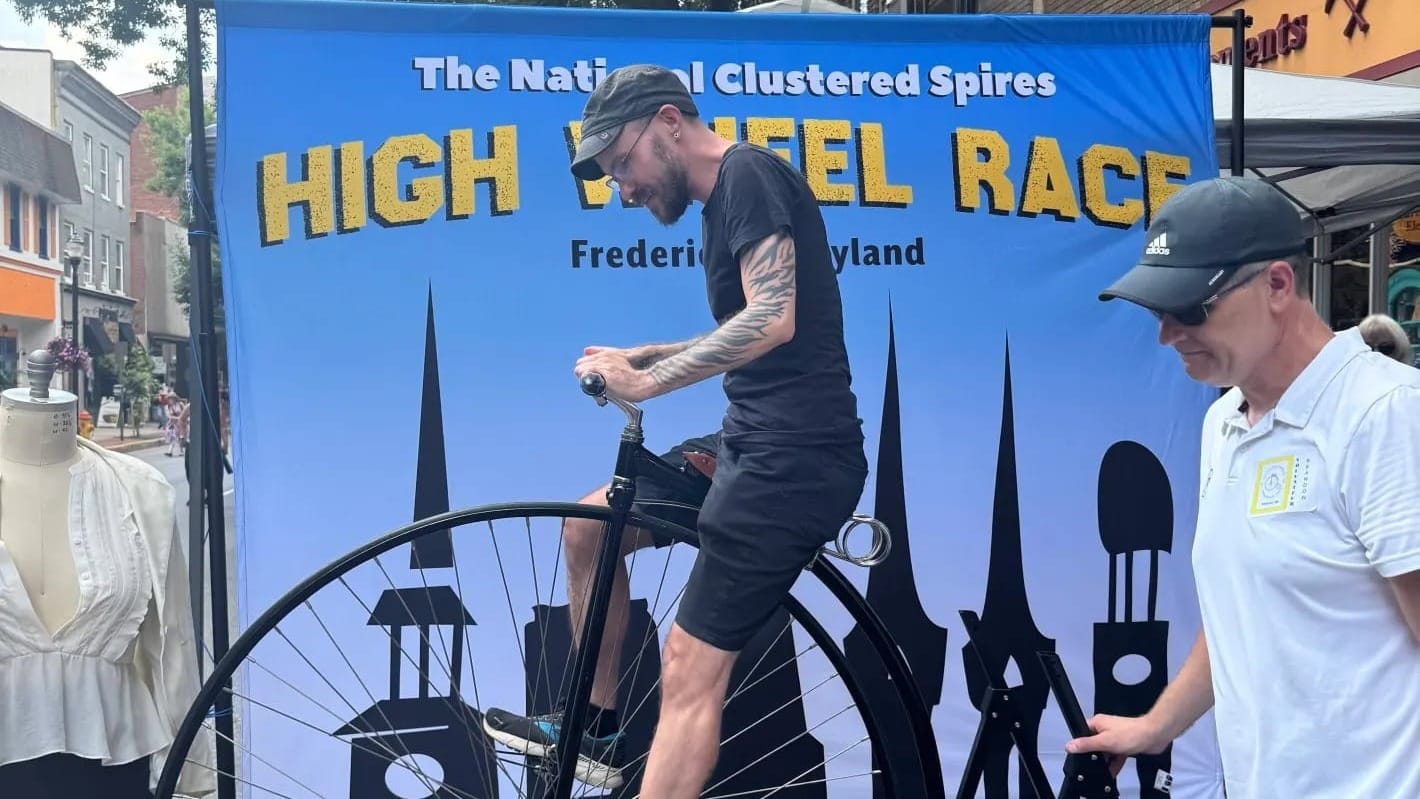
The one bike race I did in DC was a frighteningly serious affair, full of expensive racing bikes and brutal crashes in which I rode my little 80s Trek with its upright handlebars, a contrast that caused the race announcer to comment on how happy I looked pedaling along as grimly hunched racers swept past me. The atmosphere of the penny farthing race reminded me of that moment in its combination of frivolity and serious race kit. The common denominator was, of course, penny farthings, which ran the gamut of restored antiques, modern replicas, and even a few smaller designs. Some racers wore period-appropriate outfits like suspenders, knickerbockers, and waistcoats. Others wore more dramatic costumes, with colorful tights, fake tuxedos, and decorative sunhats or tricorners affixed to their required helmets. Still others wore racing gear, bike shorts and jerseys stuffed with gels and water. One racer wore a jersey for the organ donation organization Donate Life; the father of the rider’s heart donor was among the spectators.
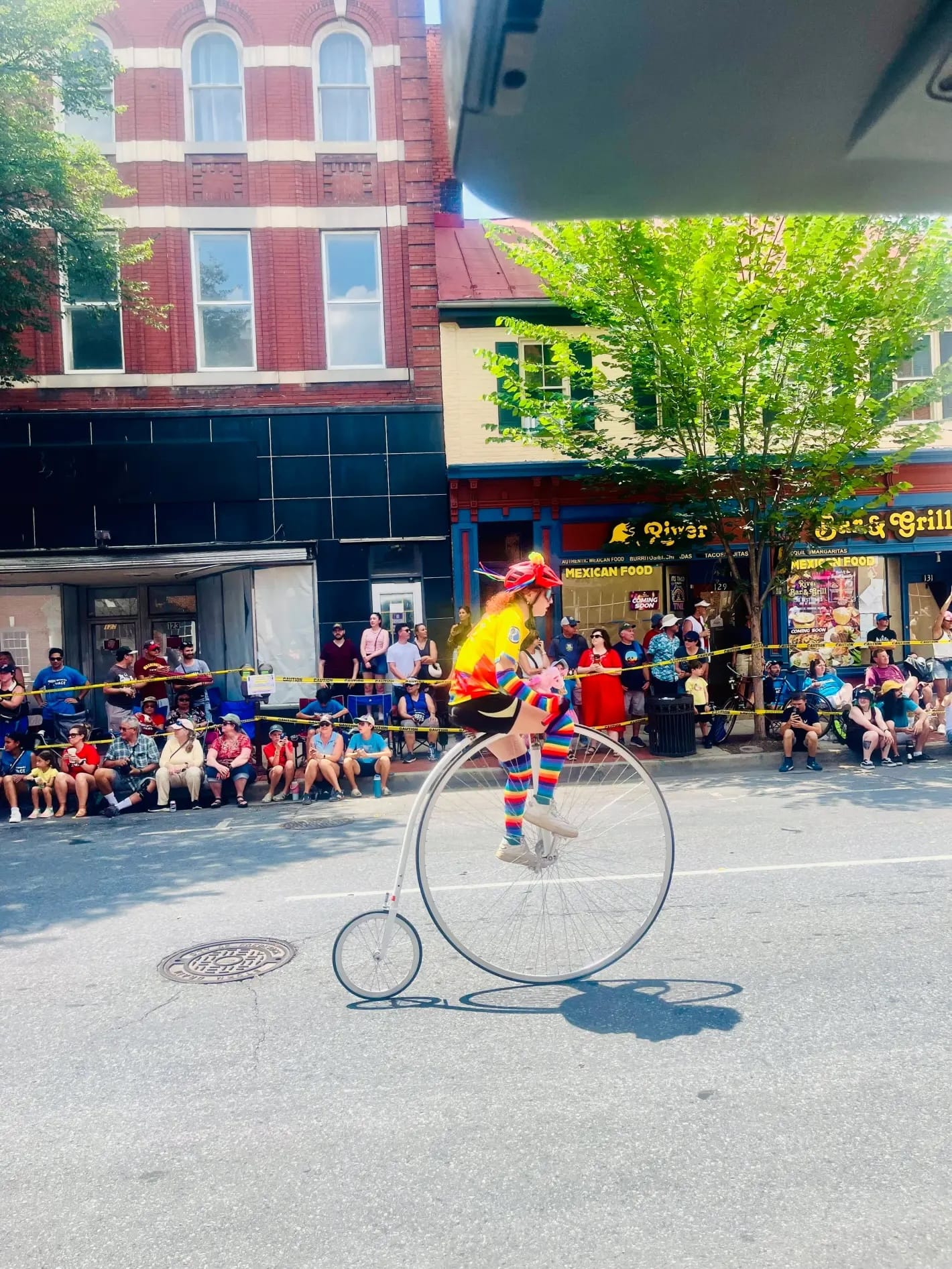
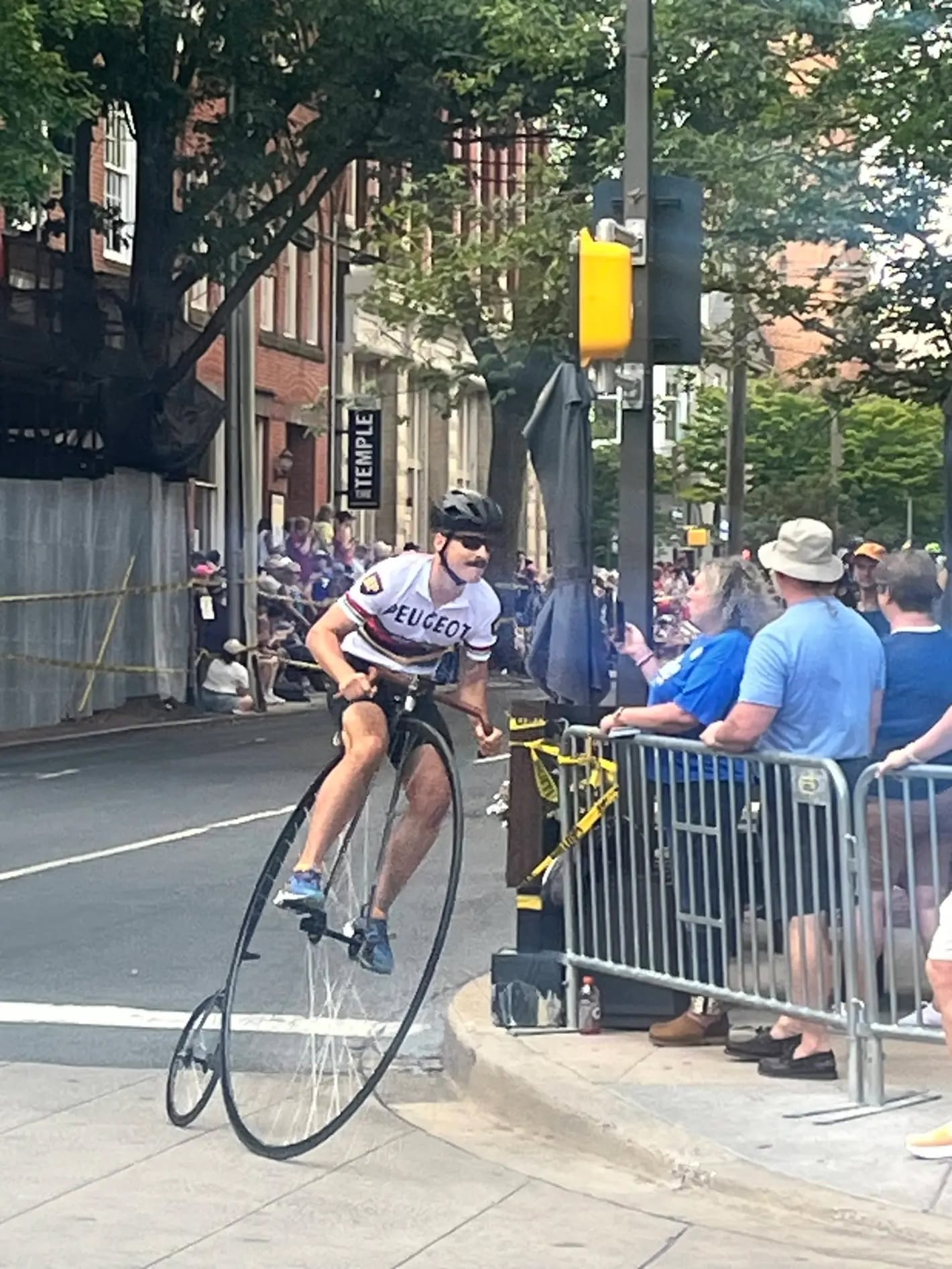
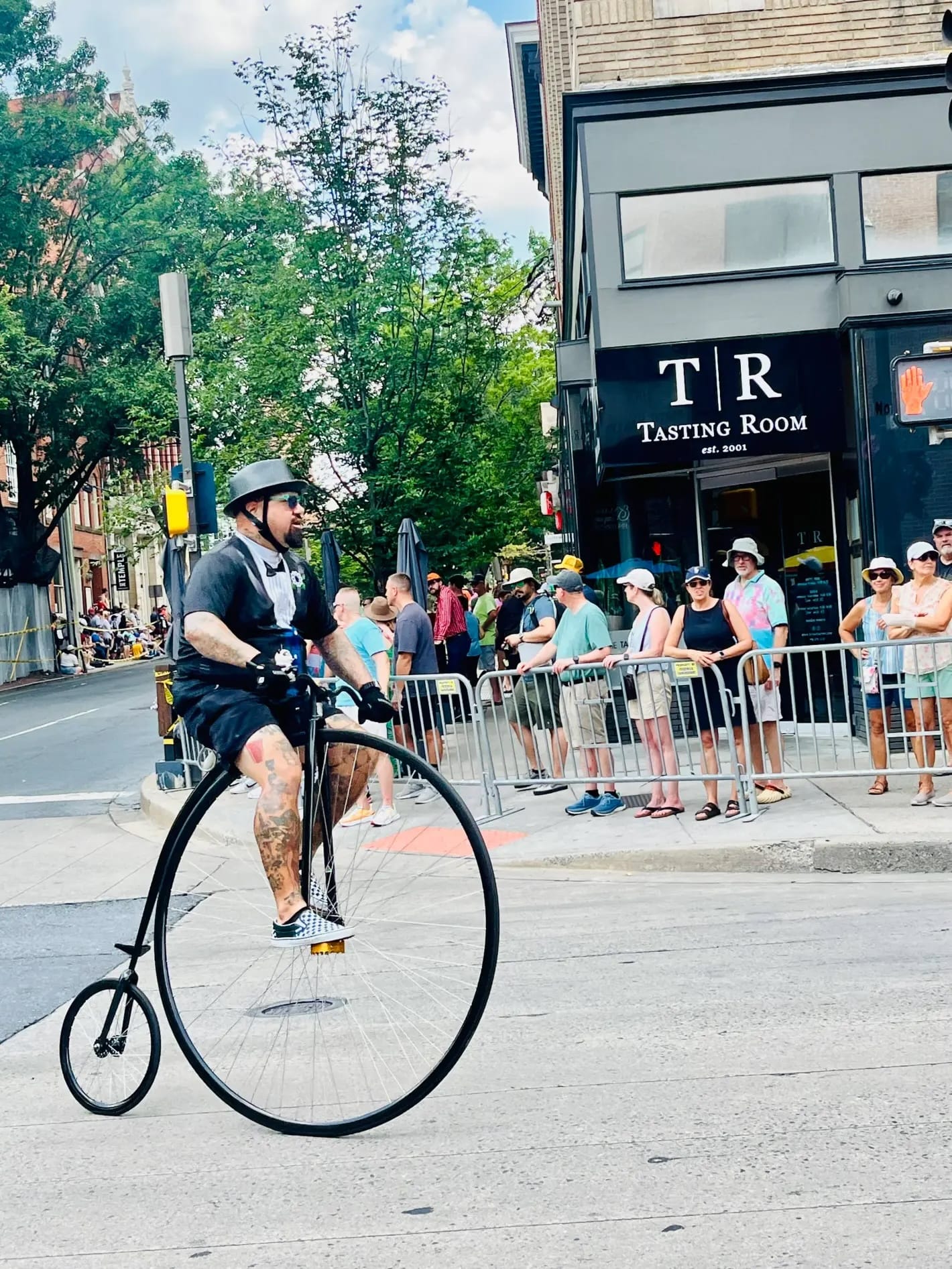
But even the silliest-dressed person looked intense and focused as they did their laps. At first, it seemed absurd to see people on penny farthings drafting each other or bending low to be more aerodynamic as they swept around the course. During the final I stood next to a man in an antique wool jersey and tall argyle socks, who told me he was a collector of vintage bikes but had only tried out a penny farthing once, at a prior year’s race, where he fell off and broke two ribs. He explained the unique strategic and physical challenge of racing a penny farthing: due to the bike’s mechanics, there’s not much chance of coming from behind or a dramatic sprint to the finish, so the race is instead a push-and-pull of getting and maintaining a lead and conserving your energy for the duration. It takes a lot of effort just to move and balance the bike, not to mention the fitness required of any bike race. As Meacham told the Frederick News-Post, “Being fit is one thing. Actually handling [the bike] is another."
I AM HAVING AN EXCELLENT DAY
— Riley MacLeod (@rcmacleod.bsky.social) 2025-07-12T16:50:30.177Z
But things weren’t all serious: In the intermission between the qualifiers and the finals, there were unicycle tricks, a “low wheel” race where riders raced the tiniest bikes they could find, and a “slow” race where penny farthings tried to go as slow as possible to cross the finish line last. This short, slow race was in many ways more harrowing than the main event, as riders wavered and wrestled gravity, towering above their spotters. The first round of the slow race had to go again when the effort made a rider veer so much that they didn’t travel in a straight enough line.
During the intermission I explored the perimeter of the course, where downtown Frederick bustled with the crowd. There were food vendors set up on the green outside City Hall, and a soda shop selling race merch and vintage sodas. Beyond just riding my bike, one of my favorite things about my DC-area bike trips was getting to see new towns for the first time, and I scrambled around reading informative history markers and admiring the old architecture. After the race, my friends convinced me not to buy an autoharp from a nearby pawn shop, and I failed to convince them to visit the National Museum of Civil War Medicine, both of which were probably for the best. We escaped the sun and heat by eating some very good Thai food and browsing a freakishly large antiques store. The racers all appeared to have their afterparty at a brewery off the course, and it was wild to see so many penny farthings lined up in the alley like you’d see any other bikes after a group ride.
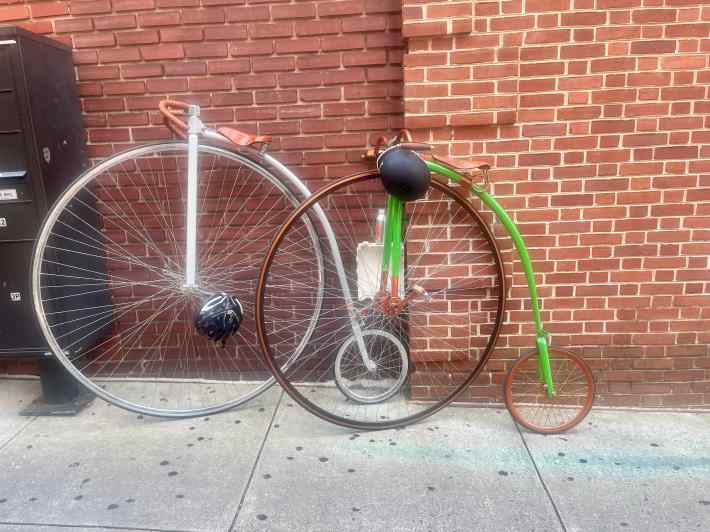
If anything bad came of my day, it’s that I learned that a small penny farthing can be had for a few hundred bucks, which would make it not impossible for me to take part in the Frederick race next summer. My friends didn’t entirely talk me out of this ridiculous idea when I shared the fruits of my online shopping research in the car back to NYC the next morning, but this plan reminded me of how swiftly my bike-riding time in DC had ramped up into feats that brought me stress as well as happiness. Maybe as a consequence of the years I spent drinking about my feelings instead of having them, I’m not very good at just enjoying enjoyable things, instead having a tendency to push their limits rather than just let them be what they are. So hopefully I will not buy a penny farthing of my own (unless you are a reader looking to offload one?..).
The best thing about the race was the best thing about all of my bike trips: getting out of the grooves of my own head and into the world. Even though I'm back in New York and in a job Jeff Bezos can't dissolve on a whim, I still struggle with feeling stuck sometimes. I still dream of just vanishing into the woods on my bike when the pressures of owning a business and the horrors of the world feel inescapable. Leaving all that behind to learn about some new niche subculture, to see people thriving in a unique world they've made and to get to share it with them, was the perfect antidote for these times, and even worth living my dream via car instead of ridiculous bike journey.


